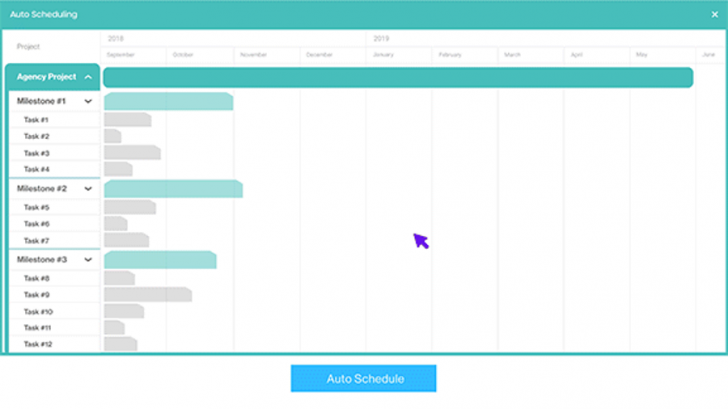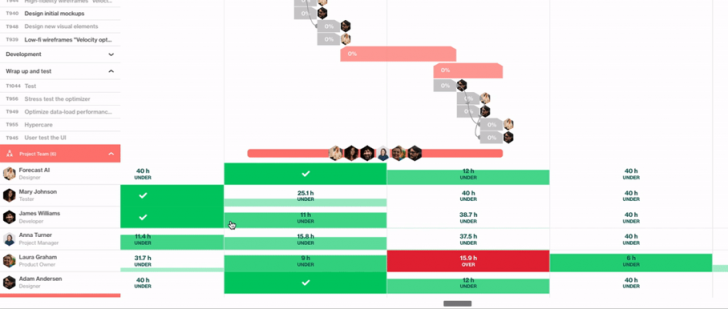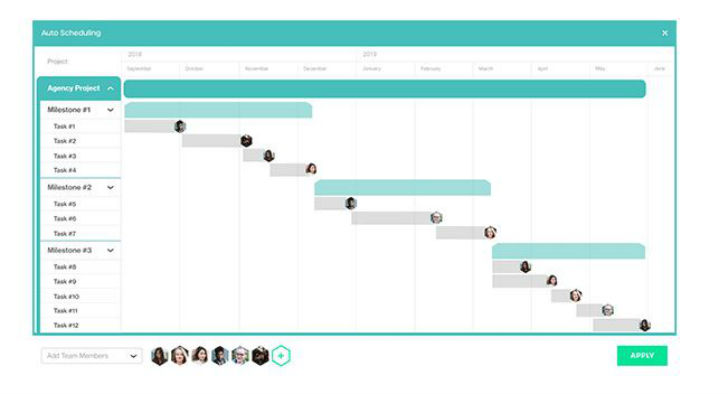
The AI learns from previous projects, learning who completed them and the time taken to complete different tasks. The machine learning aspect uses data from the Forecast platform to make better decisions for each project. It will always respect:
- Existing workload of staff
- Consider high priority tasks first
- Consider dependencies
- Blocked or unapproved tasks are not factored. The Auto Schedule system flags if these exist during the initiation of the process
- Done tasks are ignored as they do not require resources
- Where 0 hours remain on tasks, these are also not factored in.
The AI will also consider resource availability, task information, comments, and labels against the task. Project managers can assign labels against specific task types such as #Design, #Website and #Javascript.
As important, is that the solution will indicate when a project plan cannot be completed within a given timescale with the resources available. This was one of the early benefits found when Forecast tested the solution within its marketing team. The Auto Schedule tool indicated that their projects could not be completed within normal hours in a given month. This allowed them to decide whether to bring in temporary resources, allow overtime or de-scope the work.
Where can a project manager use Auto Schedule?
At the moment the solution is only available on task allocation projects. It is initiated on the Scoping and Timeline pages. Once the decision is made to automate the project plan, the user is taken through a wizard to set up the parameters for that project. Options include being able to lock or automatically re-assign people to tasks, allow flexible milestone dates and overlapping milestones.
Once complete, the user enters a preview mode where the system transforms the project from a list of tasks to a fully formed project plan with resources allocated. Tasks are organized with dependencies taken account of, people allocated and estimated time. If the task data is incomplete, the AI will estimate based on historical tasks, the role required and the time taken for those tasks. Auto Schedule algorithms are weighted toward historical data from the business concerned. However, initially it will consider the wider data set from all Forecast customers when completing tasks.
Project managers are then able to review and edit the plan using a drag and drop Gantt chart interface to take account of other factors not available to the AI. Over time, the AI learns more about the people in the business, their patterns of work and abilities. It considers whether to include them in the project schedule or an alternate resource.

Another benefit of the solution is that the project manager can see the impact of other projects on their own using a heat map view. As conflicts appear the heat map indicates where changes are needed. As resources are moved to new tasks, the simulation refreshes the heat map so the project manager can quickly see the optimal allocation.

Where more than one project manager simultaneously accesses the system, it works on a first come first served basis according to Forecast. Both managers will be able to access the resource in preview mode. However, once one Project Manager clicks the apply button the resource is allocated. The second project manager will see that the resource is now unavailable in the heat map.
Project managers are also able to duplicate an existing project, to repeat the process for a different client, for example. The system will prompt if they wish to use the Auto Schedule option as they create the duplicate.
Benefits
Forecast highlights several benefits to business of this new solution:
- It improves the efficiency of project managers, reducing the burden of resource management but allowing them to retain control. This not a case of 100% automation but augmented intelligence.
- Operation directors and finance managers will notice an uplift of accuracy in forecasting. In turn, this should improve utilisation and efficiency.
- It allocates an equal level of work for all employees. This reduces the risk of burnout and aims to deliver a fair share of work for employees.
Enterprise Times: What does this mean
Forecast claim that this is the first AI driven auto scheduling solution. However, other PSA firms have delivered similar solutions with overlapping functionality. One example is Kimble Applications with the Intelligent Resourcing it announced in its Summer 18 release.
This is the first iteration of Auto Schedule which was demonstrated in a Beta version. Several upcoming improvements were noted during the web demonstration. This includes the addition of collaboration when project managers are working on resourcing simultaneously. Forecast may also want to look at how project managers enter or update time entries the system. It appeared as though the user would have to manual enter numbers rather than having a quick to use + and – button or equivalent.
What impressed was the amount of time that this solution could save resource managers though. As a first generation feature it holds much promise for the future. It will be interesting to see the feedback from customers once it is used in earnest. This is another step completed on the Forecast journey to providing a project automation tool rather than just a project management tool.


























